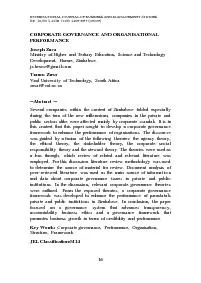International Corporate Reporting Chapter 11
Author : calandra-battersby | Published Date : 2025-06-23
Description: International Corporate Reporting Chapter 11 Corporate governance Definitions Corporate governance is the system by which companies are directed and controlled Cadbury Report UK focus on process The collections of control mechanisms
Presentation Embed Code
Download Presentation
Download
Presentation The PPT/PDF document
"International Corporate Reporting Chapter 11" is the property of its rightful owner.
Permission is granted to download and print the materials on this website for personal, non-commercial use only,
and to display it on your personal computer provided you do not modify the materials and that you retain all
copyright notices contained in the materials. By downloading content from our website, you accept the terms of
this agreement.
Transcript:International Corporate Reporting Chapter 11:
International Corporate Reporting Chapter 11 Corporate governance Definitions ‘Corporate governance is the system by which companies are directed and controlled.’ (Cadbury Report, UK, focus on process) ‘The collections of control mechanisms that an organisation adopts to prevent or dissuade potentially self-interested managers from engaging in activities detrimental to the welfare of shareholders and stakeholders.’ (this wording includes potential motives) Definitions (contd) ‘Corporate governance is the system of checks and balances, both internal and external to companies, which ensures that companies discharge their accountability to all their stakeholders and act in a socially responsible way in all areas of their business activities.’ (this wording focuses on wider accountability beyond immediate principal-agent duty of directors) OECD Principles Principles of corporate governance: Ensuring the basis for an effective corporate governance framework. The rights and equitable treatment of shareholders and key ownership functions. Institutional investors, stock markets, and other intermediaries. The role of stakeholders in corporate governance. Disclosure and transparency. The responsibilities of the board. Disclosure and transparency 1 the financial and operating results of the company; 2 company objectives and non-financial information; 3 major share ownership, including beneficial owners, and voting rights; 4 remuneration of members of the board and key executives; 5. information about board members including their qualifications, selection process, other directorships and whether they are regarded as independent by the board; 6 related party transactions; 7 foreseeable risk factors; 8 issues regarding employees and other stakeholders; and 9 governance structures and policies, including the content of any corporate governance code or policy and the process by which it is implemented. Responsibilities of the board of directors act in the best interests of the company and the shareholders; treat all shareholders fairly; apply high ethical standards; fulfil certain key functions (listed in the report) including ensuring the integrity of the accounting and financial reporting system, making arrangements for independent audit, and ensuring that appropriate systems of control are in place for risk management, financial and operational control and compliance with law and standards; align key executive and board remuneration with the longer term interests of the company and its shareholders (covering also selection, compensation and monitoring of key executives); exercise objective independent judgement; and oversee the process of disclosure and communications. Corporate governance models Shareholder-centric Primary responsibility of a company is maximisation of shareholder wealth. Corporate governance codes or laws are focused on meeting the needs of shareholders. Stakeholder-centric Shareholder is














